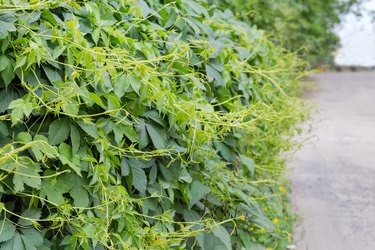
Virginia creeper (Parthenocissus quinquefolia) is a woody, fast-growing vine that will spread as a ground cover or grow up nearby walls, trees or other supports. Killing Virginia creeper is not easy once the vines have been established, but it can be done with a bit of work. The vine grows in U.S. Department of Agriculture plant hardiness zones 3 to 10.
About Virginia Creeper
Video of the Day
Virginia creeper is easy to grow and features attractive green foliage that turns to a beautiful red during the autumn months. In addition, it has small flowers that attract pollinators and black or blue berries that attract wildlife, such as songbirds, while being resistant to deer.
Video of the Day
The vines grow in a wide range of soil types, and they are tolerant of many challenging environments, including heat, drought, salt, pollution and compacted soil. They can grow in full sun, part shade or even dappled sunlight. These factors make Virginia creeper an attractive and easy to grow ground cover or climbing vine. However, the plant is not without challenges nor is it easy to remove, so consider this carefully before planting this vine in your garden.
Virginia Creeper Problems
Virginia creeper berries may be attractive to wildlife, but they are extremely toxic to humans, which can be especially problematic if you have children. The berries contain oxalic acid, and consuming them may cause symptoms such as abdominal pain, nausea, vomiting, diarrhea with blood, dilated pupils, headache, weak pulse, facial twitching and even death. The sap from the leaves may cause skin irritation.
The vines are rated as extremely flammable, which can pose a danger to your home and other structures should a fire break out. It also has the ability to cling to structures on its own and can damage some materials, such as shingles and painted walls.
In addition, the perennial vines grow an extensive root system. While this contributes to the plant's ability to thrive in diverse conditions with minimal care, it also makes removing established vines incredibly difficult.
Killing Virginia Creeper
Young plants can be removed manually, but once the roots become established, it is not practical to manually remove the entire root system. Any live roots left in the ground can regrow. The best method of killing Virginia creeper is to use a nonselective herbicide, such as Roundup, which contains the herbicide glyphosate.
The best time to apply a glyphosate herbicide to control the vine is in the late summer or early fall. There are a couple of ways to do this. You can apply the herbicide to the vine and the foliage, making sure at least half of the leaves are fully treated. Alternatively, you can cut the vine near ground level and immediately apply the glyphosate to the exposed stump. Multiple treatments may be necessary to fully control Virginia creeper.
Herbicide Safety Considerations
Be sure to follow all of the instructions and safety recommendations listed on the product label. Keep in mind that glyphosate is a nonselective herbicide, which means if the Virginia creeper vine is growing near other desired plants or is entwined with them, you will need to take extreme care when applying the herbicide to avoid killing the other plants in your garden.
Make sure children and pets are not in the area when spraying glyphosate. It is safe for them to return to the yard once the spray has fully dried.